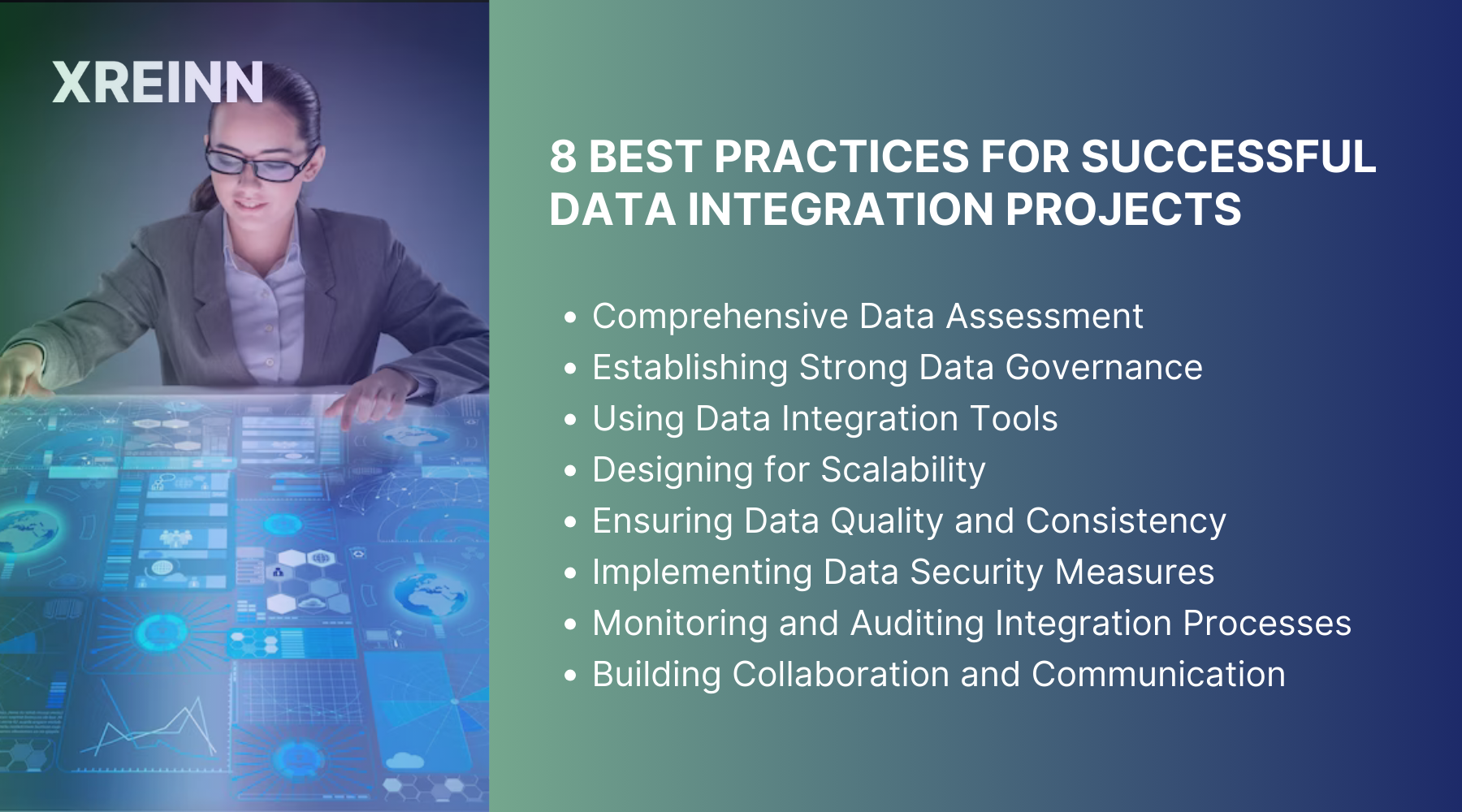Data Integration
8 Best Practices for Successful Data Integration Projects
Aug 01, 2024
Data integration is not just a technical necessity but a strategic advantage. Successful data integration projects can transform how your organization uses information, leading to more informed decisions and streamlined operations. However, achieving this level of integration requires more than just connecting different data sources; it demands a complex approach that balances technical expertise with strategic planning.
So, for a better understanding of data integration projects, we will guide you through eight advanced best practices that will ensure your integration efforts are not only effective but also transformative for your business.
8 Best Practices for Successful Data Integration Projects

1. Comprehensive Data Assessment
Before starting on the technicalities, you need to thoroughly analyze your data environment. This involves identifying all data sources, understanding their formats, and determining their importance to your integration objectives. Evaluate data quality and consistency across sources. You should also identify any potential data barriers that might exist within your organization. This initial assessment will provide a clear picture of what you are working with and highlight areas that require special attention.
How to Do It?
To begin your data integration project effectively, start with a comprehensive inventory creation by listing all your data sources, including databases, APIs, flat files, and cloud storage systems. Following this, employ data profiling tools to meticulously analyze the quality, completeness, and consistency of the data across these sources. This analysis will help in identifying any gaps or inconsistencies, a process known as gap analysis, which is crucial for highlighting inconsistencies and ensuring data integrity.
Additionally, engage in stakeholder consultation to gain a deeper understanding of the context and significance of different data sets by involving data owners and users in discussions. This holistic approach will lay a solid foundation for your data integration efforts.
2. Establishing Strong Data Governance
Data governance is important for ensuring data integrity and security throughout the integration process. You need to define clear policies and procedures for data access, usage, and quality control. This includes setting up a data management framework where specific individuals or teams are responsible for maintaining data quality and compliance with regulatory requirements.
How to Do It?
Begin by developing comprehensive data governance policies that encompass data security, privacy, and usage. This policy development will ensure a standardized approach to managing data across your organization. Appoint data management for each data source to oversee data quality and ensure adherence to these policies. Implement role-based access controls to restrict sensitive data access to authorized personnel only, thereby improving data security.
Additionally, maintain detailed audit trails that log data access and changes, providing accountability and facilitating compliance with regulatory requirements. This structured approach to data governance will significantly improve the integrity and security of your data integration projects.
3. Using Data Integration Tools
Utilize advanced data integration tools that offer strong capabilities for extracting, transforming, and loading (ETL) data. These tools should support various data formats and provide automation features to streamline the integration process. You should also look for tools that offer real-time data integration capabilities, enabling up-to-the-minute data synchronization across systems.
How to Do It?
Start by evaluating and selecting ETL Tools that match your specific integration requirements and data formats. This careful tool selection is important for managing your data effectively. Configure automation workflows to handle routine data extraction and transformation tasks, streamlining operations and minimizing manual intervention.
Additionally, implement tools that support real-time data synchronization to ensure timely data availability and maintain up-to-date information across all systems. Ensure that the chosen tools are scalable and capable of handling growing data volumes and increased integration complexity. This comprehensive approach will improve the efficiency, accuracy, and scalability of your data integration processes.
4. Designing for Scalability
As your data integration needs evolve, your system must be able to scale accordingly. Design your data integration architecture with scalability in mind, ensuring that it can handle increased data volumes, additional data sources, and more complex integration requirements. This involves adopting scalable technologies and architectures, such as cloud-based solutions and microservices.
How to Do It?
Design a scalable architecture that incorporates a modular approach, allowing for easy accommodation of new data sources and increased data volumes. Use cloud-based data integration platforms to take advantage of their inherent scalability and flexibility. Implement a microservices architecture to enable independent scaling of various components, ensuring that each part of your system can grow as needed without affecting the others.
Additionally, load balancing techniques are used to distribute data processing workloads efficiently, optimize performance, and prevent bottlenecks. This comprehensive strategy will ensure that your data integration architecture remains strong and adaptable to future demands.
5. Ensuring Data Quality and Consistency
Maintaining high data quality and consistency is important for successful data integration. You need to implement data validation and cleansing processes to detect and rectify errors. Establishing data quality metrics and continuously monitoring them will help ensure that your integrated data remains reliable and accurate.
How to Do It?
Implement validation rules to ensure data accuracy and completeness during the integration process, safeguarding the integrity of your data. Utilize data cleansing tools to correct errors, remove duplicates, and standardize data formats, improving the overall quality of the integrated data. Define and monitor key data quality metrics such as accuracy, completeness, and timeliness to maintain high standards. Additionally, set up automated continuous monitoring to detect and address data quality issues in real-time, ensuring that any inconsistencies are promptly identified and resolved. This comprehensive approach will maintain the reliability and accuracy of your integrated data.
6. Implementing Data Security Measures
Data security should be a top priority throughout your integration project. This involves encrypting data both in transit and at rest, implementing strict access controls, and ensuring compliance with relevant data protection regulations. You should also have a strong incident response plan in place to address any security breaches swiftly.
How to Do It?
Use strong encryption protocols to protect data during both transmission and storage, ensuring its security throughout the integration process. Implement multi-factor authentication and role-based access controls to restrict data access, allowing only authorized personnel to handle sensitive information. Ensure your data integration processes comply with data protection regulations such as GDPR and CCPA, maintaining legal and ethical standards. Develop and regularly update an incident response plan to address potential data breaches promptly, ensuring a swift and effective response to any security incidents. This comprehensive security strategy will safeguard your data and ensure compliance with relevant regulations.
7. Monitoring and Auditing Integration Processes
Continuous monitoring and auditing of your data integration processes are essential for maintaining system performance and data integrity. You should set up real-time monitoring to detect and address issues promptly. Regular audits will help you identify areas for improvement and ensure compliance with governance policies.
How to Do It?
Use real-time monitoring tools to track data flows, system performance, and potential errors as they occur, ensuring immediate detection and resolution of issues. Conduct regular audits to review data quality, security, and compliance with governance policies, maintaining high standards and accountability.
Implement alert systems to notify relevant stakeholders of any integration issues or anomalies, enabling swift corrective actions. Define and monitor performance metrics to ensure your integration processes consistently meet desired efficiency levels. This proactive approach will help maintain the integrity and effectiveness of your data integration efforts.
8. Building Collaboration and Communication
Effective collaboration and communication among all stakeholders are crucial for the success of data integration projects. This involves regular meetings, clear documentation, and a collaborative approach to problem-solving. Engaging all relevant teams early and often will help ensure that everyone is aligned and working towards the same goals.
How to Do It?
Schedule regular meetings with stakeholders to discuss progress, challenges, and solutions, ensuring everyone remains aligned and informed throughout the project. Maintain detailed documentation of integration processes, policies, and procedures to provide clear guidance and reference materials.
Use collaboration tools such as project management software and communication platforms to facilitate effective teamwork and streamline communication. Establish feedback loops to gather input from stakeholders, allowing you to make necessary adjustments and improvements to the integration process. This approach builds collaboration and continuous improvement, enhancing the overall success of your data integration projects.
Conclusion
Integrating data from various sources is a complex but rewarding attempt. By following these eight best practices, you can ensure that your data integration projects are successful, delivering accurate, timely, and valuable insights for your organization. Remember, the key lies in thorough planning, strong governance, and continuous improvement. With these strategies in place, you'll be well-equipped to manage the complexities of data integration and fully use the potential of your data assets.

Data Analytics
Jun 27, 2024Master key concepts in data analytics with practical tips to enhance decision-making and achieve success in your projects and professional growth

Data Analytics
Jul 01, 2024Learn the essential stages of the data analytics workflow to turn your data into valuable business insights and drive growth.

